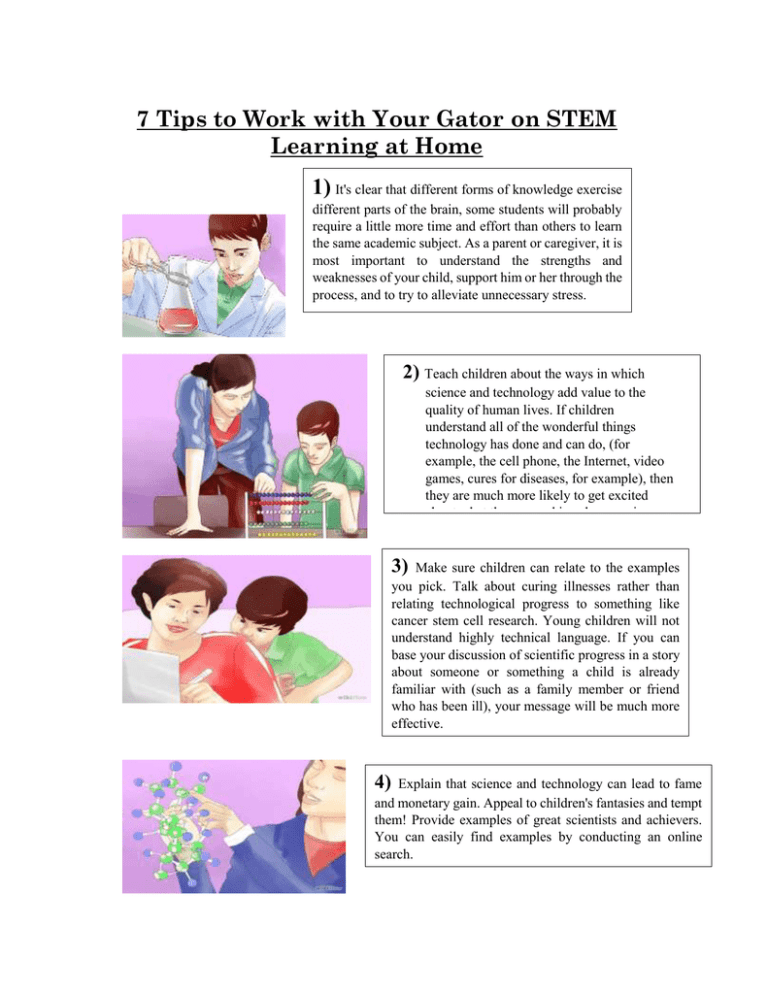7 Tips to Work with Your Gator on STEM Learning at Home
advertisement

7 Tips to Work with Your Gator on STEM Learning at Home 1) It's clear that different forms of knowledge exercise different parts of the brain, some students will probably require a little more time and effort than others to learn the same academic subject. As a parent or caregiver, it is most important to understand the strengths and weaknesses of your child, support him or her through the process, and to try to alleviate unnecessary stress. 2) Teach children about the ways in which science and technology add value to the quality of human lives. If children understand all of the wonderful things technology has done and can do, (for example, the cell phone, the Internet, video games, cures for diseases, for example), then they are much more likely to get excited about what they can achieve by pursuing an education in science and technology. 3) Make sure children can relate to the examples you pick. Talk about curing illnesses rather than relating technological progress to something like cancer stem cell research. Young children will not understand highly technical language. If you can base your discussion of scientific progress in a story about someone or something a child is already familiar with (such as a family member or friend who has been ill), your message will be much more effective. 4) Explain that science and technology can lead to fame and monetary gain. Appeal to children's fantasies and tempt them! Provide examples of great scientists and achievers. You can easily find examples by conducting an online search. 5) Teach critical inquiry skills to your child in the early stages of his or her life. Start by demonstrating how to observe, ask questions, create hypotheses, and test those hypotheses. Inquiry is the basis of science, math, and technological activity. When one is interested in how something works and then makes discoveries, the desire to learn more ignites! 6) View science and technology TV channels with your child. Engage in discussions about what you viewed afterward. Try an experiment that you saw demonstrated on TV or in a video. Part of the fun can be gathering the items needed to perform it as well as setting up the "experimental lab." Conduct Internet searches on performing fun experiments. There are many sites dedicated to science projects for kids. Make home experiments fun occasions. Organize groups of kids to participate at your home, in your backyard, garage, or another safe place. Join or organize science and technology (S&T) related groups on social networks like Facebook and LinkedIn in order to brainstorm with other parents and caregivers. You might even be in contact with teachers in S&T through these online communities. Become a member of the local science museum and keep a watch on activities for kids. Incorporate regular visits into your family's activities. Use building blocks, puzzles, and games for family activities. Leave these in obvious places so that kids pick them up, play with them, and view them as part of their everyday surroundings. Most importantly, engage in conversation about science-related topics with children in way that pertains to everyday life experiences. 7) Bring science and technology closer to life by pointing out its daily applications. Help children understand how science and technology have led to such things as running water, electricity, and cars. Create a before-and-after scenario in order for your child to realize that people did not always have running water, electricity, or cars. By explaining the history of technology, your child will begin to comprehend that technology is related to progress and serves a very important purpose in day-to-day living.

